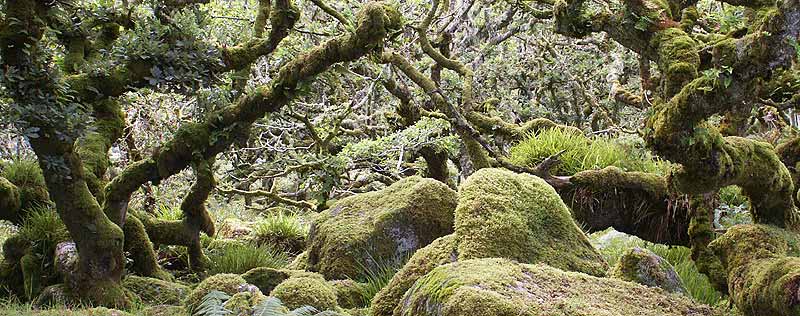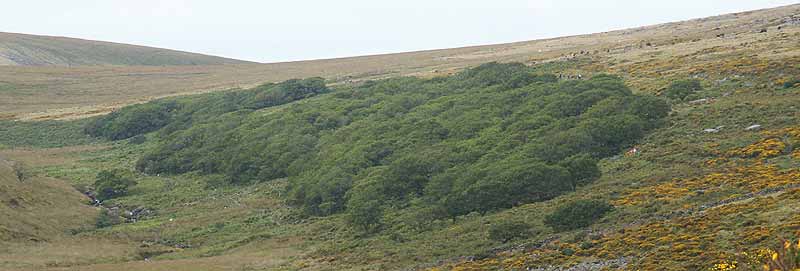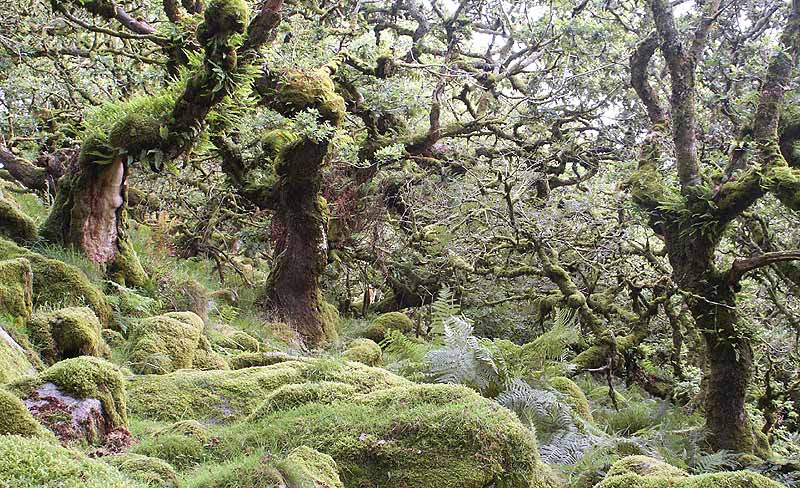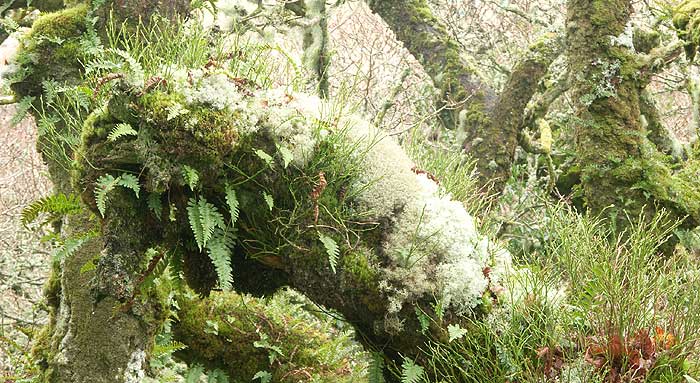Wistman's Wood
An ancient woodland on Dartmoor

By Andrew Westcott
-- Links to other pages I've written --
Home Page
Amateur Radio
Concert Master
Coxparo
Gin Traps
Grimspound
Rust Electrolysis
National Explosives
Solar Hot Water
Wistmans Wood
Doddi Mines
Rants
Dog Walker
Zombies!
JS Email
Telephone Intercom
Whetstone Mining
It is generally accepted that thousands of years ago Dartmoor was a heavily wooded area, with perhaps only the highest points on the moor being devoid of trees. Nowadays, Dartmoor has very few deciduous wooded areas and these generally exist in isolation, the rest of the moor consisting of rough grasses, heather and gorse, and large areas of peat bog. This change in the appearance of the moor has been attributed almost entirely to the actions of man, who in the earliest ages chopped down trees to use as a valuable resource, while in later times heavy grazing by livestock ensured that any saplings that did manage to get a foothold in this now hostile environment never made it to maturity.

Wistman's Wood looking North from further down the valley
Wistman's Wood is one of only three of these small, isolated ancient woodland areas on Dartmoor and is located on one side of a valley at a height of about 1,300 feet above sea level. It has historically been described as consisting of three distinct regions or groves of oak trees, amounting to a total area of around eight acres. Nowadays the regions are less distinct and the wood may be taken as one wood. There is some disagreement as to how this woodland came about, and many suspect that it may be a remnant of the original ancient woodland which once covered the moor. It is true that many of the trees here are very old, but all are badly stunted due to a combination of the high altitude and the poor rocky ground in which they grow, and therefore their relatively small size belies their age.
The woodland has been designated a Site Of Special Scientific Interest (SSSI), but unfortunately the number of visitors in the last 3 years or so has grown to such a proportion that erosion is now a major concern, and considerable damage is occurring within the wooland itself by careless people. I suppose I could be part of the problem by creating a web page about this wonderful place, but in mitigation I've only ever entered the wood itself 3 times for photographic purposes, the most recent being in the mid-90s. There is a risk that this wood's increased popularity is putting it in danger,

Within Wistman's Wood, showing the stunted trees
Certainly, one of the main reasons Wistman's Wood has survived to the present day despite heavy grazing in the area by sheep is that it is sited in an area of clitter, this being the local name given to the remains of eroded tors which have tumbled down the hillside. This clitter takes the form of many large granite boulders almost entirely covering the ground within Wistman's Wood which have effectively prevented grazing animals from entering the area, who would have otherwise gradually destroyed the young trees and prevented the regeneration of the woodland.
Trying to ascertain an age for Wistman's Wood is an almost impossible task, although it has had a mention at various points in local history which can at least give us some food for thought. One source refers to a tradition, which the reader is advised to disbelieve, in which the wood was originally planted by the hand of a certain Isabella De Fortibus, wife of William, the then Earl Of Albermarle. Isabella is said to have died in 1292, being the 'last of the ancient line of De Redvers'. Slightly more recently in 1620, a certain Tristram Risdon wrote after visiting the wood that the trees were 'no taller than a man may touch to top with his head', although it is uncertain exactly which part of the wood he visited, and as the tree size varies considerably this represents an unreliable measure of height, although it does give a date at which the wood existed. Bear in mind the average current tree height within the wood has been estimated at six metres.
With regard to the boulders and the undergrowth within the wood, it is stated on one of the information boards that a geological survey party attempted to walk through the wood in 1912, but gave up after three hours as the going was too difficult. The situation doesn't seem to be quite as bad now, possibly because of damage caused to the undergrowth by the estimated 20,000 visitors the wood receives annually, and it was due to this that it was decided to fence off a small portion of the wood in 1965 and give it national nature reserve status to try to preserve the area as it possibly once was.

Location of Wistman's Wood, with suggestions for parking
Wistman's Wood is best approached by driving to the Two Bridges Hotel which is situated near Princetown on the B3357, which runs between Tavistock and Ashburton, and attempting to park somewhere in the vicinity, although this area is a popular starting point for moor walkers and trying to find a place to park can be a little frustrating. Access to the wood is relatively easy though, as although it involves a walk of somewhat over a mile once you leave the road, there is a good track for much of the way with the remainder of the journey over open moorland. Access to the actual interior of the wood is somewhat more difficult due to large boulders lying everywhere and the intrepid explorer must be careful not to slip on one of these moss-covered rocks and sprain an ankle.
Wistman's Wood is more than just a group of trees. Because of its altitude and climate, the trees and rocks are coated in a layer of moss, and in certain places the moss may form large clumps on the trunks and branches from which ferns and lichens grow, giving the place a mystical quality, almost as if you had been transported to an alien world. For me, this is the main attraction of this place and for those interested in macro photography, an almost unlimited array of potential images present themselves.

The covered branches
There exists an inscribed stone on the outskirts of the wood known as the Buller Stone. It is a large triangular stone with a naturally flat face and commemorates the removal of one of the trees by Wentworth Buller for study. The image below indicates the location of the Buller stone should anyone wish to have a look at it.

Location of the Buller Stone

Photo of the Buller Stone

The inscription on the Buller Stone
It is difficult to discern the full inscription due to lichens growing on the rock, but below is what I believe it to be. The measurement of the diameter is inscribed within a small circle, presumably to highlight the detail. The fact that a tree with a trunk measuring only 9 inches across proved to be around 168 years old is testament to the very slow growth of these trees.
Although difficult to read in places, I believe the inscription is as follows:
BY PERMISSION OF
H.R.H. THE PRINCE OF WALES
WENTWORTH BULLER
ON SEPT. 16TH 1868 CUT DOWN A TREE NEAR THIS SPOT
IT MEASURED 9 IN IN DIAMETER
AND APPEARED TO BE ABOUT
163 YEARS OLD
Further Information
Wistman's Wood and the West Dart Valley
An official guide to Wistman's Wood, by the Dartmoor National Park.
Wikipedia
Wistman's Wood now has an entry on here too.
The Legends of Wistman's Wood
A site detailing some of the folklore surrounding this place.
Back to top
I can be contacted at this address:
Copyright © Andrew Westcott 2003 - 2025
I'm happy for anyone to use this material for private, non-commercial or educational purposes, but credit to the author must be given. For any other use please contact me for permission.